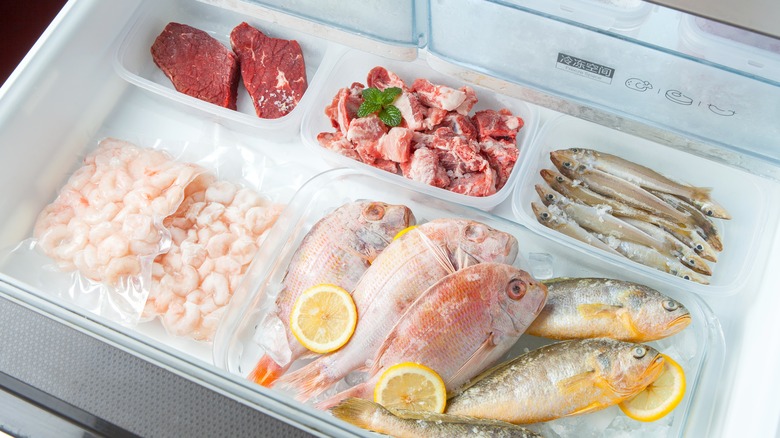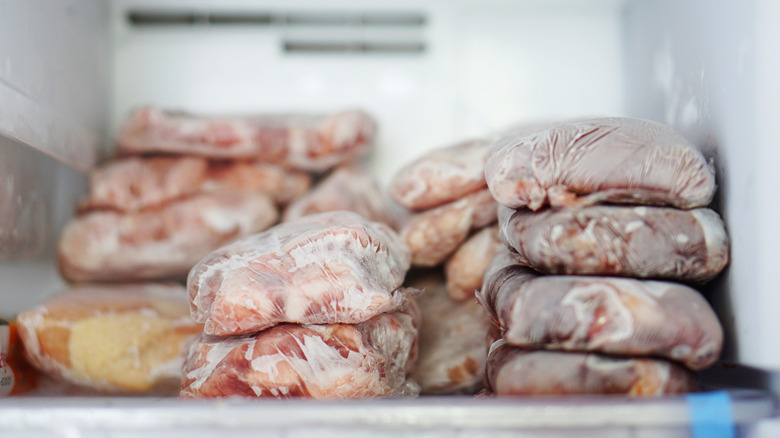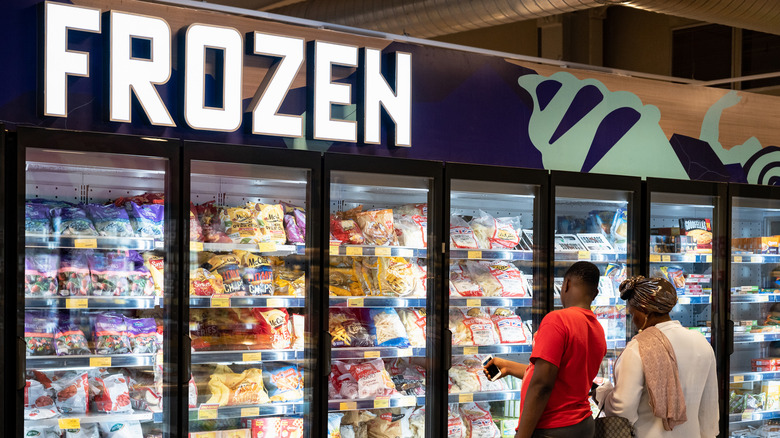The World's First Frozen Foods Date Back Thousands Of Years
If you think frozen food originated with the first Swanson TV dinners in the 1950s, think again. People have been freezing food to extend its shelf life for a very, very long time. Ice was being used as a preservative in ancient China, for instance, as far back as 3,000 B.C. Naturally occurring ice was one of several preservative methods discovered by our human ancestors. Salt curing, smoking, drying, and pickling were also common thousands of years ago, with the oldest known evidence — a deer preserved as dried jerky — dating back over 14,000 years.
The idea of freezing food continued to fascinate some of history's brightest minds over the ensuing millennia, although the methods used at times were exceedingly crude. Sir Francis Bacon, for example, the English statesman and philosopher who some believe actually wrote Shakespeare's plays, was so obsessed with the idea of frozen food that he decided to pack a dead chicken full of fresh snow to test his theories. That was in 1626, and the experiment by England's former Lord High Chancellor proved to be his last. He developed pneumonia from the cold exposure and subsequently died.
Bacon's experiment, although an abject failure, would lead to more successful innovations in the centuries that followed, and eventually a revolution in the way we consume frozen food.
Historical advances in refrigeration and frozen food
Refrigeration was the forerunner to frozen food, and efforts were being made to advance the emerging technology as early as the 18th century. The first successful refrigerator was developed in Scotland by William Cullen around 1750, albeit on a scale too small to be practical. Other great minds rallied around the cause, however, including American inventor and Declaration of Independence signer Benjamin Franklin, who was experimenting with methods of evaporating liquids for refrigeration around the time of Cullen's breakthrough.
More significant progress would be made in the 19th century. American Oliver Evans came up with a plan for a practical refrigerator in 1805, although it would be nearly 30 years before anyone actually got around to producing it. The biggest breakthrough, however, came in 1876, when German Carl von Linde figured out a means of creating perpetually liquefied gas for the purposes of refrigeration, paving the way for widescale refrigerator production in the 20th century. By the time Linde's patent was approved, the first steps had also been taken to master frozen food.
Enoch Piper earned one of the first patents for producing frozen food when he discovered a method to successfully freeze fresh fish in Maine in 1861. Perhaps not coincidentally, fresh fish would also play a big part in the developmental processes of Clarence Birdseye, the father of modern frozen food, and the man who would revolutionize the industry in the early 20th century.
How Clarence Birdseye invented modern frozen food
In the late 19th century, the first mechanical ice was produced in Australia, a significant leap forward that allowed meat to be shipped to England via onboard freezers. There was one issue, however. Ice crystals developed in the meat's cellular structure, leading to a noticeable quality decline. The man who would resolve this issue was Clarence Birdseye.
The former biology student was working for the U.S. government in Labrador, Canada, when he noticed that fish caught by Inuit people there froze almost immediately due to the frigid Arctic temperatures. He also noticed that the fish retained its flavor when it was later thawed and cooked. Birdseye's breakthrough then was developing a way to flash-freeze food to avoid the cellular deterioration that had plagued earlier methods.
Birdseye began his flash-freezing operations in the 1920s, and was transporting frozen food throughout the U.S. in refrigerated railroad cars by the 1940s. His revolutionary methods would ultimately result in 168 patents covering every aspect of frozen food production – from freezing and packaging to distribution – and forever changing the way food was stored in supermarkets and elsewhere. By 1959, when Birdseye's methods had resulted in the first Swanson frozen TV dinners, the emergent frozen food industry recorded $2.7 billion in sales. By 2022, that figure had grown to a staggering $72 billion.
Birdseye deserves much of the credit, of course, for the frozen foods we enjoy today. But he also benefited from several thousand years worth of innovation.



